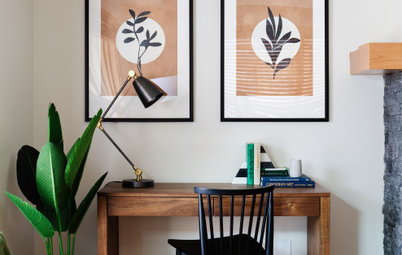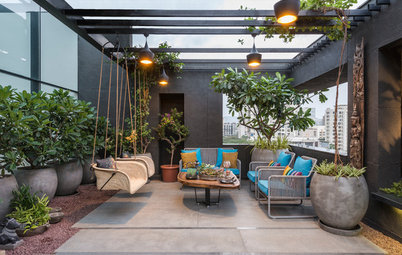How to Take Care of Your Indoor Plants
We love to keep our plants where we can see them daily, but plants kept indoors need a little extra care and attention
Indoor plants in different parts of the house are no different from the other living members of the home. They demand tender, loving care from us and a few routines to be followed. Here’s how to take care of them so they are in the best of health at all times.
2. Don’t overwater
Since we see indoor plants very often, sometimes there develops a pattern of watering them frequently even when the soil doesn’t require any extra moisture.
Believe it or not, overwatering is the number one cause for plants dying. Water only when the soil seems a bit dry. Also ensure that the soil is well-drained, as most plants hate wet feet.
5 Plants Best Suited for Indian Homes
Since we see indoor plants very often, sometimes there develops a pattern of watering them frequently even when the soil doesn’t require any extra moisture.
Believe it or not, overwatering is the number one cause for plants dying. Water only when the soil seems a bit dry. Also ensure that the soil is well-drained, as most plants hate wet feet.
5 Plants Best Suited for Indian Homes
3. Check their placement
If you keep your plants near a glass window that is closed through the day, there is a chance that the glass gets excessively hot due to direct sun. This can increase the temperature near the glass, which might char the leaves or even burn out a delicate plant.
Sift through these Houzz photos for good ideas
If you keep your plants near a glass window that is closed through the day, there is a chance that the glass gets excessively hot due to direct sun. This can increase the temperature near the glass, which might char the leaves or even burn out a delicate plant.
Sift through these Houzz photos for good ideas
Similarly, some plants don’t like a direct draft of air from the fan or the AC. If you feel the plant is in distress, try moving it from its current position within the same room or move it to a different room.
4. Remove any dead leaves
One advantage of keeping plants indoors is that we constantly keep an eye on them.
Take a close look at the state of the plant; this way you can catch any disease or distress early, before it causes much harm. One of the easiest things to do is to pluck out any dead leaves or wilted flowers on a weekly basis. This prevents pests from setlling on dead and decaying leaves, and reserves the plant nutrition for optimal use by growing leaves. It is good for aesthetic reasons, as well.
One advantage of keeping plants indoors is that we constantly keep an eye on them.
Take a close look at the state of the plant; this way you can catch any disease or distress early, before it causes much harm. One of the easiest things to do is to pluck out any dead leaves or wilted flowers on a weekly basis. This prevents pests from setlling on dead and decaying leaves, and reserves the plant nutrition for optimal use by growing leaves. It is good for aesthetic reasons, as well.
5. Add fertiliser regularly
Another way of expressing your love for your plants is to give them small, regular doses of plant food. Either home-made compost or store-bought fertiliser, just sprinkle a little bit on the top soil to give shots of nutrition to your beautiful plants.
Another way of expressing your love for your plants is to give them small, regular doses of plant food. Either home-made compost or store-bought fertiliser, just sprinkle a little bit on the top soil to give shots of nutrition to your beautiful plants.
6. Remove infected plants
After taking good care of the plants, if you still find that one of your precious plants has been hit by an insect or fungal attack, remove it and keep it away from other plants.
The most commonly occuring pest is the mealy bug, a small, white and sticky creature. Your leaves turning scaly brown is a symptom, too. Sometimes the infection can spread and harm more plants than one. In the absence of direct sun and fresh breezes, the infection spreads quicker.
How to Live With a Money Plant
After taking good care of the plants, if you still find that one of your precious plants has been hit by an insect or fungal attack, remove it and keep it away from other plants.
The most commonly occuring pest is the mealy bug, a small, white and sticky creature. Your leaves turning scaly brown is a symptom, too. Sometimes the infection can spread and harm more plants than one. In the absence of direct sun and fresh breezes, the infection spreads quicker.
How to Live With a Money Plant
7. Lastly, choose your plants wisely
There are certain plants which can do well in indoor conditions; it might be prudent to choose from amongst these plants. Any plant can survive indoors for a few days but if you want them to last longer indoors then choose your plants wisely, depending on the sunlight conditions in the room.
Look for plants and pots in Houzz products
There are certain plants which can do well in indoor conditions; it might be prudent to choose from amongst these plants. Any plant can survive indoors for a few days but if you want them to last longer indoors then choose your plants wisely, depending on the sunlight conditions in the room.
Look for plants and pots in Houzz products
Follow these few steps and enjoy your own personal sanctuary inside your house for a long, long time. Plants are soothing to the eyes, make for great decor pieces and spread a sense of peace and calm. They are a great addition to every single room.
Read more:
Indoor Plants: 7 Most Common Symptoms of Poor Plant Health
Expert Tips: How to Display & Style Indoor Plants
Tell us:
Which of your indoor plants have been living with you for a long time? Share tips and photos with us in Comments below.
Read more:
Indoor Plants: 7 Most Common Symptoms of Poor Plant Health
Expert Tips: How to Display & Style Indoor Plants
Tell us:
Which of your indoor plants have been living with you for a long time? Share tips and photos with us in Comments below.

















Most indoor plants do not require too much sun. However, they all do well if they are regularly exposed to sun for a few days before bringing them back in. Not only is sunlight a crucial element for photosynthesis, it also acts as an antibacterial and prevents onset of diseases and insect attacks. Make a schedule of taking each plant out for a few days every 8 to 10 weeks.
Find a Houzz professional to advise you on indoor plants